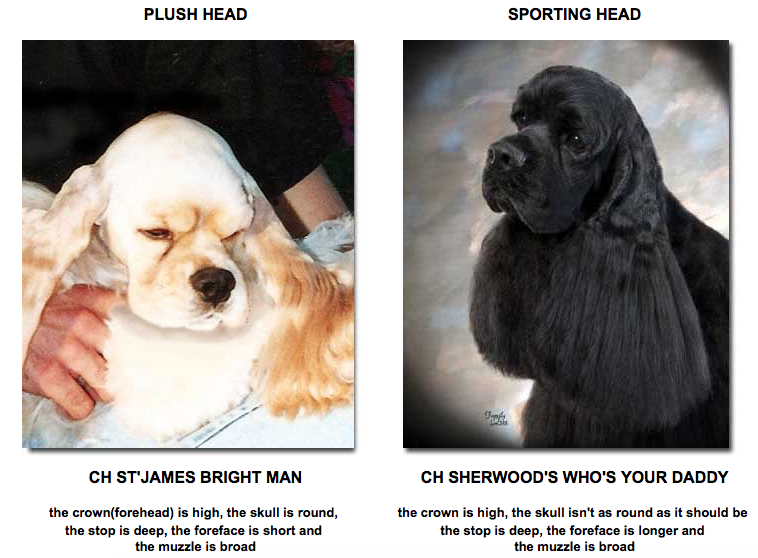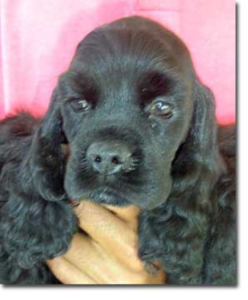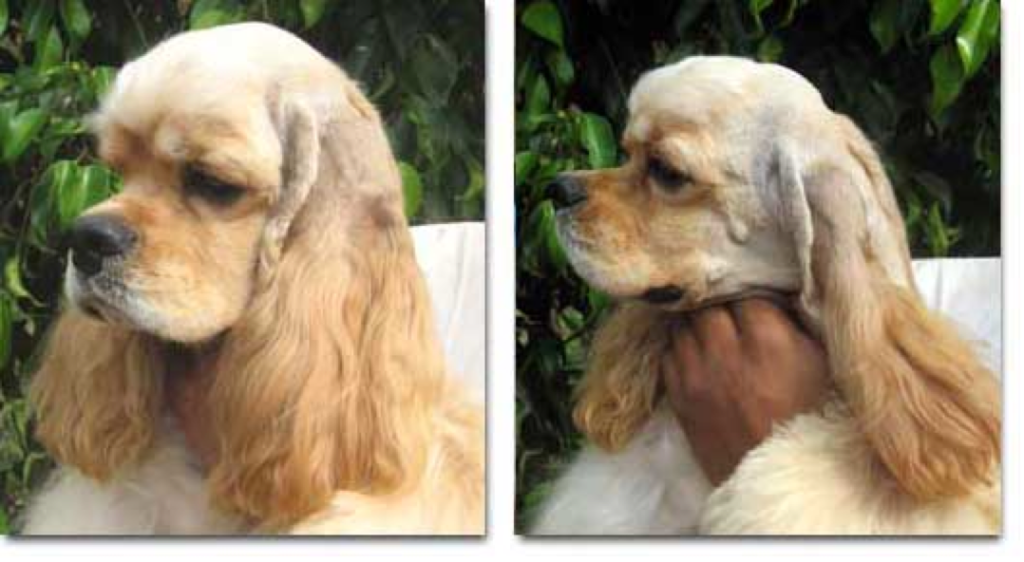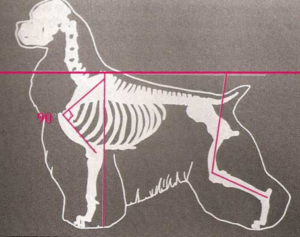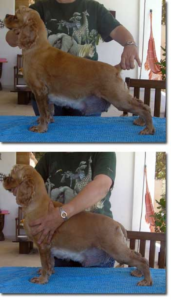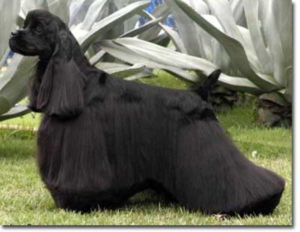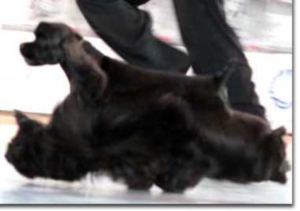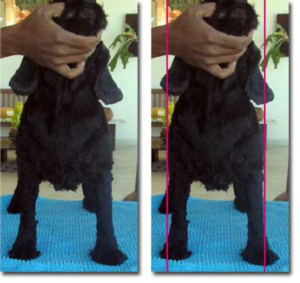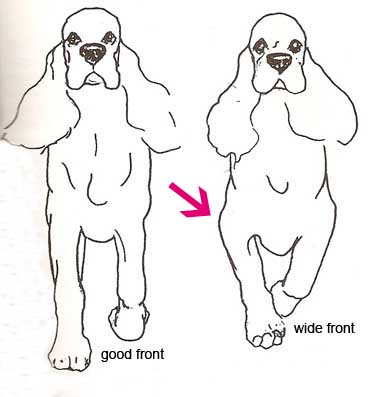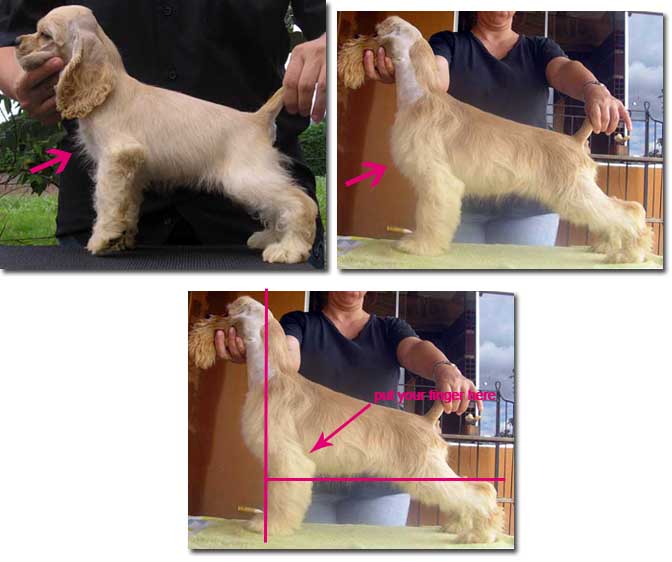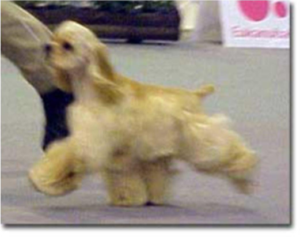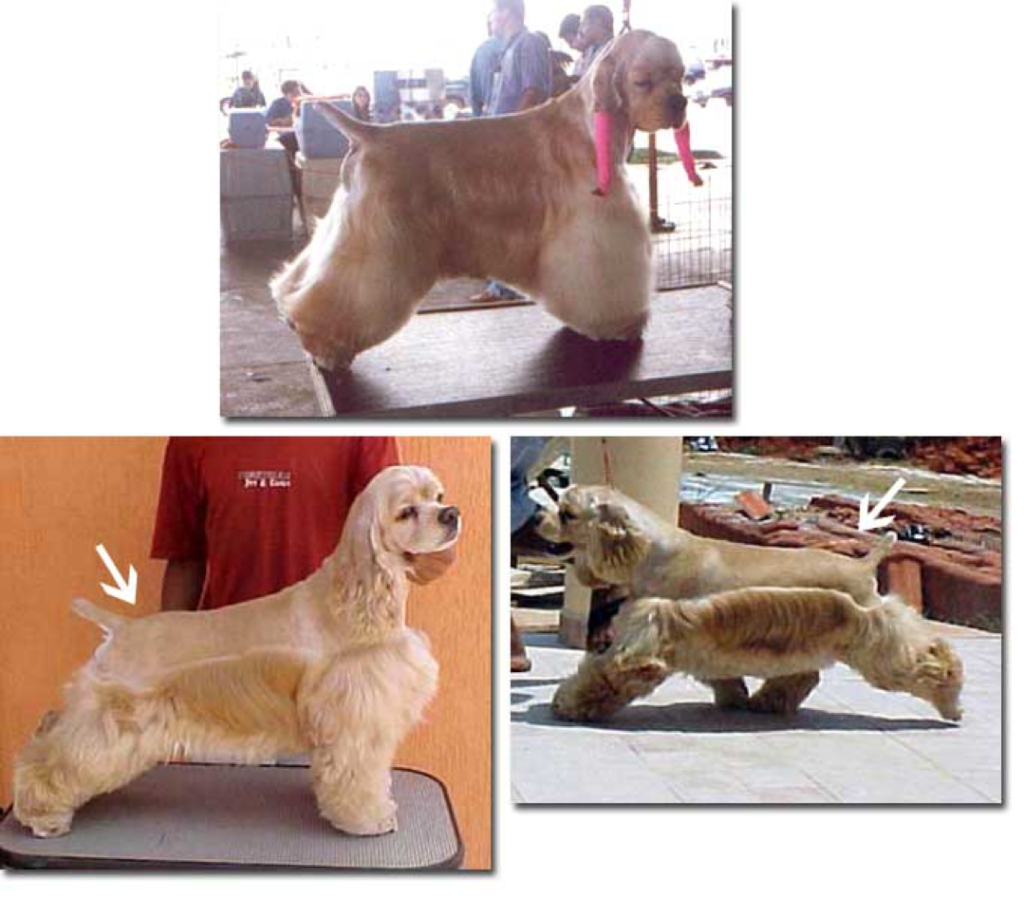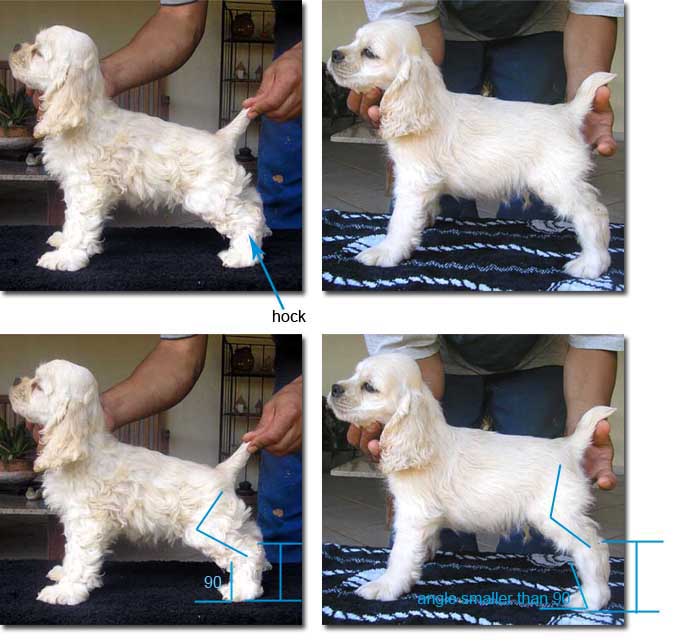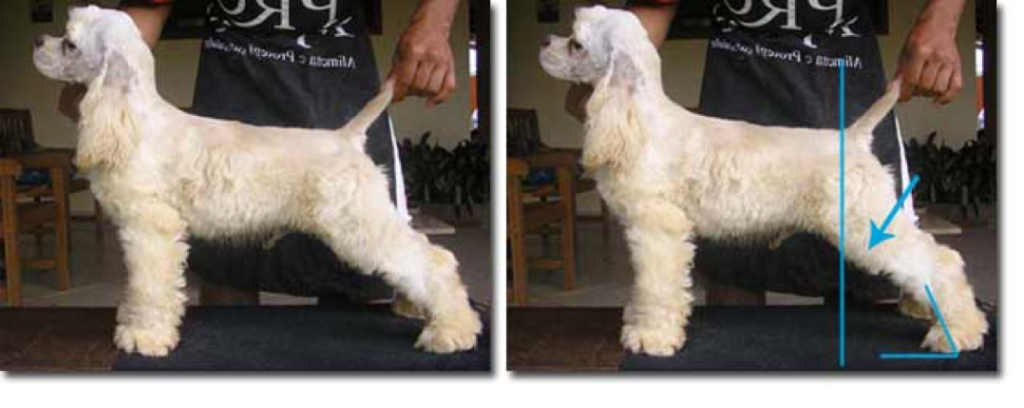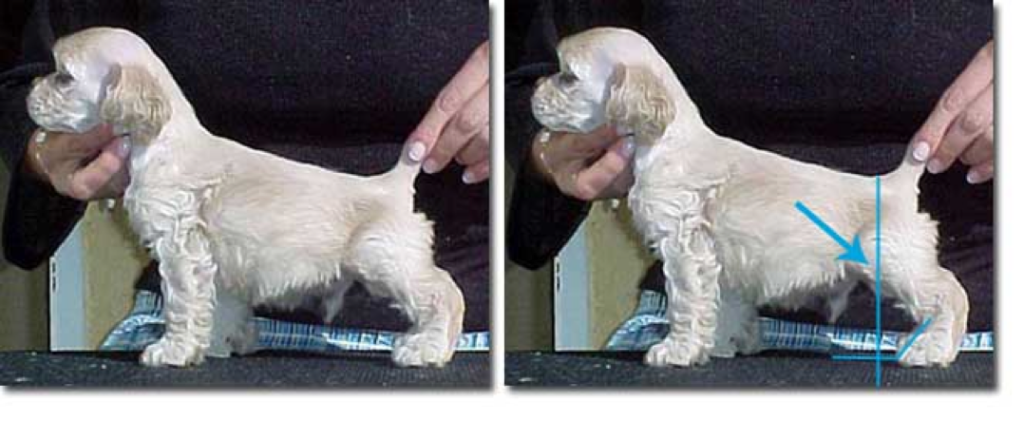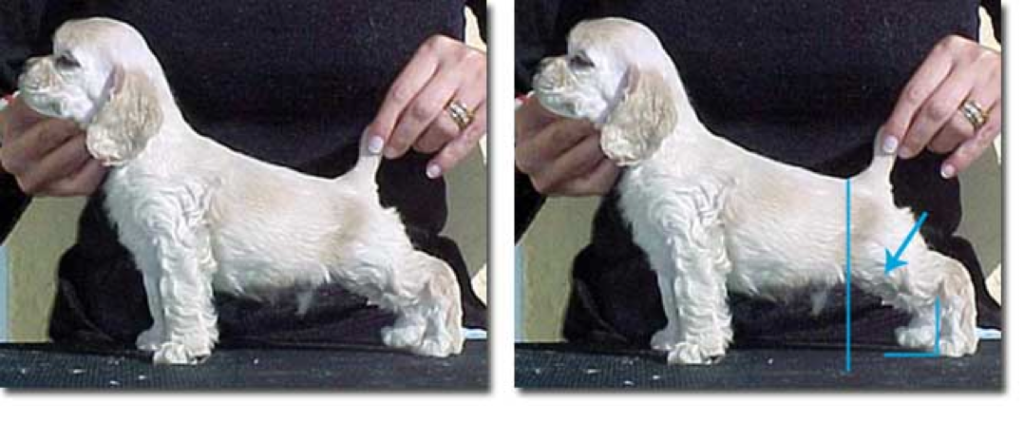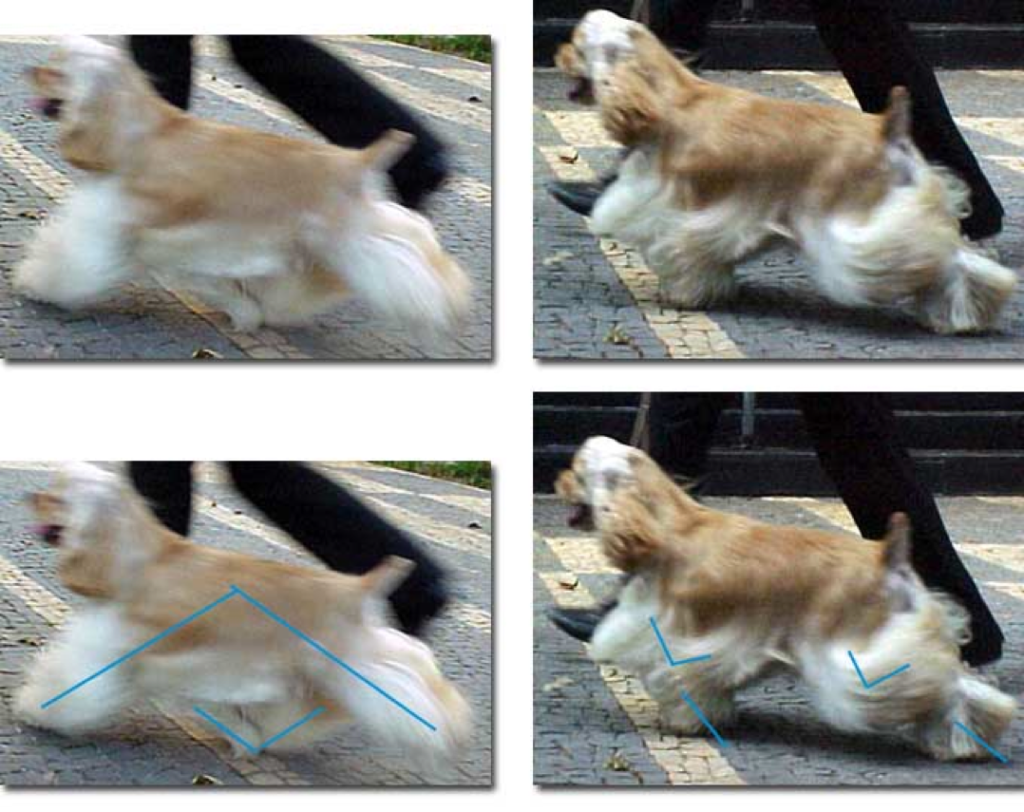The (American) Cocker Spaniel by Tais Vagostelo
This article was written by Tais Vagostelo, St' James Cockers-Brazil — donated to Connie Bliss-Cochran who edited it to be better understood from her language!
When I started to breed cockers, I remember I had a very hard time reading the standard. It was so difficult to me to understand what it truly meant, and how an ideal dog should be. But I was lucky enough to have a mentor – Mrs. Sonia Peixoto, Golden Gate Kennel in Brazil – who didn’t mind to spend hours and more hours, month after month, teaching me all the points of the standard and showing the faults and qualities of my dogs, helping me to find a good stud sire for my bitches and giving me a picture how a perfect dog must be.
However, there are so many breeders around the world who are not as lucky as I was, and thinking on them, I decided to show my interpretation of the standard, with as many photos as possible, trying to help the novices to understand the standard of our so loved breed.
Remember, nobody is able to breed to improve the standard. The standard is what it is. The breeders must IMPROVE THEIR DOGS to meet the standard. That is the goal of any good breeder and a good dog is the one who is as close as possible to the standard's description.
Never forget something: To breed good dogs you don't need any luck. You need KNOWLEDGE. If you are able to understand the standard and visualize how a good dog should be, you will not have any problems to breed good dogs. You just need luck to breed GREAT DOGS, but the decent ones are a piece of cake!
So, here we go!
« To attain a well proportioned head, which must be in balance with the rest of the dog, it embodies the following:
EXPRESSION — the expression is intelligent, alert, soft and appealing.
EYES — eyeballs are round and full and look directly forward. The shape of the eye rims gives a slightly almond shaped appearance; the eyes are not weak or goggled. The color of the iris is dark brown and in general, the darker the better.
EARS — lobular, long, of fine leather, well feathered and placed no higher than a line to the lower part of the eye. SKULL — rounded but not exaggerated with no tendency toward flatness; the eyebrows are clearly defined with a pronunced stop. The bony structure beneath the eyes is well chiselead with no prominence in the cheeks. The muzzle is broad and deep, with square even jaws. To be in corrent balance, the distance from the stop to the tip of the nose is one half the distance from the stop up over the crown to the base of the skull.
NOSE — of sufficent size to balance the muzzle and foreface, with well developed nostrils typical of the sporting dog. It is black in color in the blacks, black & tans and black & whites; in other colors it may be brown, liver or black, the darker the better. The color of nose harmonizes with the color of the eye rim.
LIPS — the upper lip is full and of sufficient depth to cover the lower jaw.
TEETH — strong and sound, not too small and meet in a scissors bite. »
The head is the most important part of any dog — Why? Which part of the dog do you look at first to recognize if that is a doberman, a cocker or a collie? The head, right? We have different opinions about how the perfect cocker head should be. Basically, there are two types of heads that meet the standard: Sporting and Plush and the difference between them should be the length of the foreface and the skull shape.
Here are two VERY BEAUTIFUL examples of each one:
Which one is the right one? That is the big dilemma!
The "plush lovers" say the skull of the sporting heads aren't round enough and the foreface is too long.
And the "sporting lovers" say the plush heads' foreface is too short and sometimes the eyes are too round. And they never will be able to work on the fields because they couldn't carry a bird.
I like the plush head better and as I think the head is so important, I do my best to breed dogs with plush ones. I am what people call a "head hunter". It is quite difficult for me to like a dog without a plush head. On the other hand, I will not think twice to use a male with a sporting head if I believe this male will help me to fix some faults in one of my bitches.
However I have noticed the sporting head is quite dominant to the plush one. Every time I used a sporting to a plush I got NO plush headed puppy. A good example are the two puppies below. The dam is the same, a bitch with a very plush head out plush headed parents. The puppy A is out the MALE A (sporting) and the puppy B is out the MALE B (plush), each puppy (they are girls) was the first "head choice" of their litters.
As you can see, the PUPPY A is in the middle of a sporting and a plush head. It has the same round skull and high forehead as the PUPPY B, the stop is almost as deep as the other, but the muzzle isn't as broad and the foreface isn't as short as the puppy B.
So, if you are a plush head lover, but all your dogs have sporting heads, I don't have good news for you. It will be very difficult you get a plush head out them. But you will be able to get plush heads in two generations. You will use your bitch to a plush male, hold the best headed girl and use her again to a plush male. You will have a good chance to get a plush headed puppy by doing that.
Another important point to identify a good head- IT MUST HAVE A FIGURE "8" SHAPE, the two elipses being almost the same size. There are more examples below (believe it or not, the particolor was bred by me. It was the only parti litter I ever bred):
More good heads with correct 8 shape:
We have 3 other kind of heads than the plush and sporty, but not all of them are correct.
There is the the dog that doesn't have a deep stop, has a plain skull, the muzzle isn't broad, the foreface is long. I don't know if there is a correct description for this kind of head. I name them CARROTS, because it is what they look like to me.
If you have a cocker with this kind of head, maybe it would be a good idea to take this out your breeding program, because it will be so hard to have good heads (even if you like the sporting type) using it. Maybe you can keep a bitch (if her body is truly nice) and use her to a very plush headed male. But if you are planning to keep a male with this kind of head … well, it must have a FANTASTIC body, the best movement and terrific temperament. But please never forget.. this is MY POINT OF VIEW.
But sometimes the dog has a high forehead, short muzzle, deep stop, but the two elipses of the "8" are not the same size, it usually happens for two reasons:
- The muzzle isn't broad enough
- The eyes are too wide
The example below is a combination of both: the eyes are too wide and the muzzle isn't broad enough.
I always used to think a head should be very plush; the plusher the better, but I found out we can have heads that are much too plush and they are not correct either. I call them overdone and it looks like a result of crossing of a boxer to a shar-pei!
You can note the stop is much too deep, "the bony structure beneath the eyes isn't well chiseled". There are so many folds under the chin and on the area at the side of the eye to the earset. Here are two examples:
There is another kind of overdone head, but unfortunately I don't have any photo. It is when a sporting head style is overdone. The dog will look like a slumber.
But I have used overdone head dogs in my breeding program and I got very good results. You can use any kind of head with them (except the plush ones) and the puppies will have very nice heads. They work very well with sporting bitches. It is the only case you can get a plush head (out a sporting head) on the first generation.
We didn't finish yet! we must pay attention in every little detail of the standard:
EYES — the standard says it is round and full, but not goggled, and the darker the better. The bitch in the photo below, has two problems with her eyes. They are goggled and could be darker. All the other dogs I used to illustrate the standard have good shape of eyes and correct color.
EARS — The standard mentions the ears are to be "of fine leather and must be placed no higher than the line to the lower part of the eye". We see the expressive high earset very often, especially on the dogs in advertisements. High earset is when the ears are placed higher than the eye line. Unfortunately you see many more cases of high earset in the plush heads than on the sporting ones. Here is an example of a high earset:
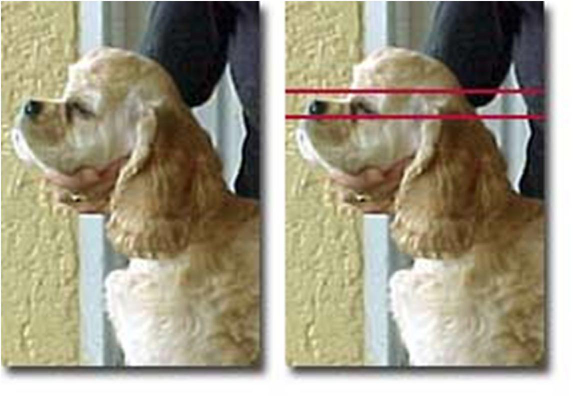
Some dogs, especially puppies, look like they have a high earset in the photos. In several cases, it is because someone is trying to get their attention for the camera. Why do they do their best to look to any other side than the camera?! It is the same dog in two different positions. His earset isn't as high on the 2nd photo as it is in the 1st one.
And finally, don't forget almost all the plush head puppies have high earset before the age of 2 months! Same puppy girl at different ages:
TEETH — The standard asks for strong, not small teeth, and for a scissors bite, we have seen in the USA, champions who have a level bite. The American judges penalize the bite as any other fault and to tell you the truth, I don't think they are that wrong. But in the other countries around the world (FCI member) the bite is so very important. The dog will be heavily penalized if it doesn't have a perfect scissors bite and it is just impossible to finish a dog with a level bite. In fact, the (FCI) judges would like to disqualify them, the only reason they don't do that, is because it is not a disqualification in the standard.
It has been a big headache for the breeders who import dogs from the USA in the past. Sometimes we import a dog who had a good bite but who produced bad ones because there are cases of bad bites in their line. But I am noticing day by day more American breeders are paying attention to the bite problems and are eliminating dogs with bad bites from their breeding program. But the small teeth still are very common, not only in the USA, but almost everywhere.
I believe the other descriptions of the standard about skull, nose and lips are very easy to understand and I don't need to comment on them.
NECK — the neck is sufficiently long to allow the nose to reach the ground easily, muscular and free from pendulous "throatiness". It rises strongly from the shoulders and arches slightly as it tapers to join the head. TOPLINE — Sloping slightly toward muscular quarters.
BODY — The chest is deep, its lowest point no higher than elbows, its front sufficiently wide for adequate heart and lung space, yet not so wide as to interfere with the straight forward movement of the forelegs. Ribs are deep and well sprung. Back is strong and sloping evenly and slightly downward from the shoulders to the set on of the docked tail. The docked tail is set on and carried on a line with the topline of the back, or slightly higher; never straight up like a Terrier and never so low as to indicate timidty. When the dog is in motion, the tail action is merry.
"The shoulders are well laid back forming an angle with the upper arm to approximately 90 degrees which permits the dog to move his forelegs in an easy manner with forward reach. Shoulders are clean cut and sloping without protrusion and so set that the upper points of the withers are at an angle which permits a wide spring of rib. When viewed from the side with the forelegs vertical, the elbow is directly below the highest point of the shoulder blade. Forelegs are parallel, straight, strongly boned and muscular and set close to the body well under the scapulae. The pasterns are short and strong. Dewclaws on forelegs may be removed. Feet compact, large, round and firm with horny pads, they turn neither in nor out.
When I started with cockers — 1993 — the fronts were the big problem in the breed and since then, it has improved a lot, but it still is what our cockers have the worst problem with. Each part depends of the other one. Bad shoulders will "destroy" the topline, bad shoulders will make your dog's neck be short, bad shoulders will make your dog not have a good reach. And the most terrible, you can fix a head in two generations (like I said before) but you will finish your breeding program with the shoulders you started with.
My foundation bitch had quite decent shoulders with a good neck . I used her with a dog with decent shoulders (at that time it was quite impossible to find a cocker with excellent shoulders) and I didn't have any truly bad shoulders in her litter.
But I decided to import my first American dog and I can tell you, its' shoulders were terrible. I used him once with this same bitch and all the 6 puppies had the same shoulders as their father. I used him with another bitch and she had only one puppy, but with the same terrible shoulders. I just placed him in a pet home as well his kids and didn't think to use him or anything out of him ever again. THAT WAS THE BEST DECISION IN ALL MY "DOG LIFE". Just a little detail — I paid US$ 2,000.00 for that dog plus shipping cost and it was in 1994!
If you want some advice, here it goes: You can take your chances with heads, with hindquarters, bites, even with temperament, but NEVER use bad shoulders in your breeding program. In few generations you can destroy all your years of hard work breeding dogs.
But let me start to explain about the shoulders and all the other important points. The standard says the shoulders are to form a 90 degree angle with the upper arm. There is no way to explain this other than using photos or drawings.
This is the ideal cocker, with proper angulation. In this drawing you can easily see the proper 90 degree angle, but sometimes we have problems seeing these angles in a "real dog". Well, things will be much easier if you remember to trace an imaginary line from the withers (nothing more than "highest point of the shoulder blade" the standard is talking about) to the ground. This line MUST TOUCH the dog's elbows. Check these photos:
The line touches the withers and elbows at the same time. It is what the standard means: "when viewed from the side with the forelegs vertical, the elbow is directly below the highest point of the shoulder blade". Much easier, right? What else are you able to see on this girl? Can you see her long neck and short back? Any clue why her neck is long and her back is short? BECAUSE SHE HAS PERFECT SHOULDER ANGULATION! Because her elbows are under the highest point of her shoulder blade. It is exactly what the standard asks for!
Like before, I traced a line from the withers to the ground, but this time it isn't even close to the elbows. Why? Because the shoulder angulation is over 90 degrees. And what about the topline? Can you see the short neck? Can you see the long back from its withers to the tailset?
Now pay attention to the 2nd line I traced, the one from the elbows to the ground. What would happen if the shoulders had proper angulation from its withers were there? This dog would be much shorter in back and with a longer neck, wouldn't it? If you get a cocker magazine and start to trace these lines you will see why people say the fronts are the biggest problem in our breed!
SO, if you want to evaluate your own dog, and if there is no one to stack it for you while you take a look on it. What to do? Use your hands! Stack the dog, put your thumb on the withers. Your little finger should touch the elbows. Check the photo below.
But did you remember when I said bad shoulders will limit dogs movement? Why it happens? Look at the pictures once again:
This time, I traced a line from the withers across to the point where it meets the upper arm and keep a linegoing straight to the ground. This line is exactly where they will put their foreleg when they are moving. It is the famous REACH! There is no way the leg can go ahead past that point, and it's not because they don't want to move, don't have attitude or is not being shown by a professional handler, it is because THEY CAN'T GO OVER THAT POINT. Their anatomy doesn't allow them to do that.
Looking at both of them side by side, can you see how the black & tan's shoulders are well laid back, like the standard asks for? So, every time you read or hear something about well laid back shoulders you now know how it should be! Now pay attention to the ground. The black and tan will be able to put her leg much farther ahead than the black one, right? It means she will cover much more ground than the other, with a single step. Now imagine the difference it will be in one day working on the fields. But I will talk more about this when I start to work with the GAIT subject.
Just another important thing: When you are watching a dog in movement (especially in a dog show) pay attention to its front legs and on the nose (YES, THE NOSE). A dog with a good reach will be able to put his foreleg ahead of his nose. If it is not able to do that, it is because it doesn't have a good reach and its has problems with the angles of its shoulders. Let's see what I am talking about:
This is a Brazilian dog bred by one of my good friends — CH Good Advice Total Eclipse, aka Jordan.
Now Jordan in movement. Can you see his front leg is ahead of his nose?
Now the same photo with some lines so you see better what I am talking about:
It wasn't that difficult, was it?
Now you already know how to evaluate a good head, layback of shoulders & long neck. Believe me, the head can change, but the shoulders never will. Bad shoulders never will be good ones. And the opposite doesn't happen too. Sometimes it can improve A LITTLE, but don't wait for MIRACLES, ok? I have some photos to prove what I am saying. Take a look at this girl. Since she was 15 DAYS OLD I was pretty sure how her shoulders should be. DON'T FORGET TO TRACE THE IMAGINARY LINE, ok?
I will repeat this again: To breed good dogs you don't need any luck. You need KNOWLEDGE. If you are able to understand the standard and visualize how a good dog should be, you will not have any problems learning to breed good dogs. You just need luck to breed GREAT DOGS, but the decent ones are a piece of cake!
But we are not done with the fronts. We must check the ribs. The standard says: "its front sufficiently wide for adequate heart and lung space, yet not so wide as to interfere with the straight forward movement of the forelegs. Ribs are deep and well sprung."
This is a diagram of a cocker, front view. You can see the ribs on it. If the ribs are not wide enough, the dog will have a narrow front, but if it is too wide it will force the elbows to be out, like a bulldog front.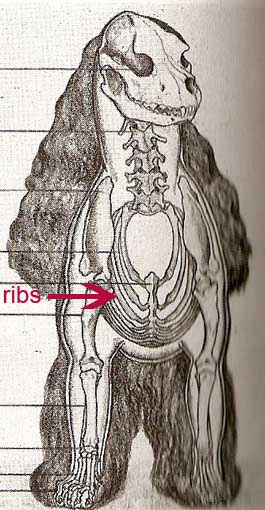
These are the three types of front:
Another photo of a good front. This time I am using a shaved down dog. I traced lines at the side of its scapulaes. The forelegs are exactly under it, showing how a proper front should be. Read again what the standard says: "Forelegs are parallel, straight, strongly boned and muscular and set close to the body well under the scapulae."
Don't forget about what the standard says about the ribs and movement "it is not so wide as to interfere with the straight forward movement of the forelegs". Let's see what happens with the movement of a dog with wide front:
Pay attention to the elbow. Can you see it is "out" of the dog's body while it is moving? I know it looks like it could be difficult now, but believe me, you will be able to see it even the dog is in full coat. In fact, it is easier to see when the dog is in show coat, because you will see the coat going to that direction while the dog is moving. You just need to train your eyes a little.
Sometimes we hear the expression: "this dog needs more substance". Usually people are talking about the fronts. The dog who needs more substance is the one with the narrow front.
Some puppies with a narrow front will improve with exercise. By the way, exercise is the best thing for any puppy. Some breeders don't like to do that, saying it will damage the coat. Remember, that a coat can grow out when the dog is older, but the same will not happen with the dog's structure. Exercise works great for the rears too, but we will talk about that later.
We are almost finished with the fronts. We only need to talk about the chest and forechest. The standard asks for a deep chest, "its lowest point no higher than elbows". There is no way you "see" how deep a chest is in a dog in show coat; but you can feel it. Put your finger on the elbows (there is an arrow showing the right place), the chest must be deeper than your finger. By the way, it is a good test for the ribs too. If there is a "space" between your finger and the ribs, it is because the ribs are not wide enough. Ribs with good shape will be very close to the elbow.
The photos above are of the same girl. When she was 2 months old, you already could see her fore chest (check the arrow). She had a good fore chest at that age and kept that when she was an adult. I traced one line in front of her foreleg. The forechest must be ahead of the line.
And I traced another line to show where her chest "finishes". If you put your finger on the arrow (exactly on the elbow) you will be able to touch her chest.
Now, a puppy without enough fore chest. It is easy to see the problem when the dog doesn't have much coat, but in full coat, it is quite difficult, especially with a good trimming. It will be necessary to touch the dog to feel the problem.
FINALLY! We are done with the fronts. To conclude, the dog with a good front MUST have proper shoulder angulation (90 degrees) + good rib cage (not narrow, not too wide) + deep chest + good amount of forechest + parallel forelegs.
TOPLINE — Sloping slightly toward muscular rear quarters. Back is strong and sloping evenly and slightly downward from the shoulders to the set on of the docked tail. The docked tail is set on and carried on a line with the topline of the back, or slightly higher; never straight up like a Terrier and never so low as to indicate timidty. When the dog is in motion, the tail action is merry.
Beside the fact I am a "head hunter", I agree there is something in cockers (or any other breed) which is more important than the heads. It is the TOPLINE. What is the topline? It is the neck + back + tailset. A dog with a good topline is half way to being a good dog.
Basically there are three kind of toplines, but I don't know how to say that in English. But let's see:

As the standard says, the back must be strong and sloping.
- The first puppy is a good example how a good back should be.
- The puppy in the middle has a curve (roach) to it. Some lines have this type of roachy back on the puppies, but when the dog is an adult, the back will be ok. That was the case of this puppy as well as her dam. I saw them growing up and their backs were absolutely strong before one year old. I have one friend who is a very famous schnauzer breeder in Brazil and he says he has the same in his line. Some of his puppies has this curve, but when adults have the best backs. But how do we know if the puppy will have a hard back in the future or will keep the curved (roached) back? Only by using a crytal ball. There is no way to know. So, maybe it is better to don't take your chances keeping a puppy like this.
- The other puppy is what I call a soft back. It is the same kind of a horse back (sway back) and I never saw one puppy with this kind of back that will be ok when it is an adult. It is quite the opposite. It never improves but can get worse with age. Some puppies have good backs when young, but because they are overweight they can become soft backs when adults. And it happens very often with bitches after they have puppies.
With a good trimming and experience stacking the dog, it is not difficult to cover the problem when the dog is stacked. So, the best way to see if the dog has a bad back is to watch the dog moving. Unfortunately, I don't have photos to show them in movement. But here is a photo of a perfect sloping back in movement:
We have three kinds of tailset: NORMAL, LOW TAILSET AND TERRIER TAILSET.
This is an example of a LOW TAILSET. When the dog is stacked and in show coat, with a proper trimming, it is very difficult to see the problem. But when it is moving, the problem will show up:
"Hips are wide and quarters well rounded and muscular. When viewed from behind, the hind legs are parallel when in motion and at rest. The hind legs are strongly boned, and muscled with moderate angulation at the stifle and powerful, clearly defined thighs. The stifle is strong and there is no slippage of it in motion or when standing. The hocks are strong and well let down. Dewclaws on the legs may be removed."
As I did with the fronts, I will show the proper angulation. This is a photo of a bitch with very good angulation, front and rear:
Why I am saying she has very good angulation? Let's take a look on the diagram I used to show the front angulations:
Now I am using the same lines on the photo:
Can you see she has the same angulation as the drawing? It means she is BALANCED — another term used frequently by breeders — and a dog with this kind of angulation will be able to move very well. And it isn't just theoric, this bitch is a great mover.
To understand the rear angulation and its movement (it is called DRIVE) it is necessary to think in "to bend" and "to jump". I know, it doesn't seem to make sense, but I will show you my point.
You are standing up and start to bend your knee. The more you bend, the higher you will be able to jump, right? The same thing happens with the dogs rear but the dog will not jump, it will "push the ground". The more angulation the dog has (bend in the knees), the more it will be able to push the ground, commonly called 'DRIVE'. The bend in the knee is also called bend of stifle.
This also means that a dog with less angulation (the knees don't bend enough) will not be able to 'push' the ground properly (less drive) and an over angulated dog (knees bend too much) will 'push' the ground too much (too much drive)
Pay attention to these two puppies, littermates, pictured on the same day. It is important to say I resized the photos and the puppies have exactly the same height , ok?
The first puppy has proper rear angulation and the 2nd one less angulation. Can you see the knee of the first puppy is much more bent than the second one? What else you can see on these puppies? Do you see the first puppy has a sloping back and the second one a level back? Why it happens? Because the second puppy's knees aren't as angled as they should be!
You can think the second puppy isn't well stacked, but it is the "comfortable" position for him. How do I know that? Because the hock must be in 90 degres with the ground. In fact, his hock is a little ahead than they should be and you can see the angle with the table is less than 90 degrees. It is the reason we say THIS DOG NEEDS MORE ANGULATION, the angle should be higher.
Another interesting bit of information. Pay attention to their hocks. Can you note the first puppy has smaller hocks than the second one? Every time you see a dog with a high hock it is because it doesn't have enough angulation. In fact, I believe a lot of problems with rear angulation are because the size of hocks. As the higher the hocks are, the less angulation the dog will have.
What I don't know is the following: the dog has high hocks because it has less angulation or it has less angulation because it has high hocks? If someone has the answer for this question, please let me know.
Now let's see other photo of the 2nd puppy when he was a couple of months older:
This time we put his legs as far back as possible, trying to improve his topline. But he still is "level" backed and not as a sloping back as it should be. The hocks still are at an angle smaller than 90 degrees. I traced a line of the end of his back (where the tailset starts) to the ground. The knee should go ahead of that line, but his doesn't. There is an arrow showing where his knee is.
Why the knee can't go ahead of that line? Because when it happens his legs will not bend enough to push the ground properly.
Check again the photo of the bitch with good rear angles. Trace an imaginary line on her tailset to the ground and check her knees. Her knee isn't behind the line like the other puppy, her rear legs are still bent and ready to push the ground. Here is her photo again:
Now let's see the last example, the over angulated rears. This puppy is over angulated. When I stacked him I could see his knee was not ahead of the line of his tailset.
Take a look at his hock. Can you see the angle with the ground (table) is more than 90 degrees?
But what would happen if I stack this same puppy and put his hock on the proper angle (90 degrees)? His knee would be after that line and that is not right. See the photo:
Maybe you are starting to wonder if a dog over angulated is much better:
- He will be able to move faster because he will "push the ground" much more.
- A dog over angulated has short hocks (good point)
- Dog who is over angulated always have a sloping back (great point)
Believe or not, a lot of breeders thought the same in the past. Nowadays over angulated dogs are so common in the rings, but they forgot about the balance of the dog. The front will not be able to follow the rear movement even if the dog has a good front. And we shouldn't forget that until 1992, that cockers were to be 15% shorter in their backs than in height
Try to have a picture. The fronts were terrible, no proper angles and you already learned a dog with that characteristc doesn't have GOOD REACH. The rears were over angulated, it means the dog had TOO MUCH DRIVE. And the back should be short! To reiterate: IT WAS IMPOSSIBLE FOR THE DOG MOVE PROPERLY. The best movers were the ones with long backs. What happened? They changed the standard in 1992, and the dogs should now be longer backed.
I know a lot of people will not agree. They will say there are other reasons, but it is hard for me to agree with a dog who is overangulated, for the reasons like pain in the back (someone already told me about that). But just remember IT IS MY OPINION.
You should keep this in mind — A GOOD DOG IS A BALANCED DOG. The rear and front should work together, ok?
Now we must see the rear from another view:
These are the photos of the same bitch. The first one around 45 days old and the other when she was an adult. You can see her legs are parallel, not so wide and not so narrow. It is how correct rears should look like.
There are two other kinds: cow-hocked (the hocks almost touching each other) and another one who would be exactly the opposite: The hocks are too far apart and the legs has the same shape as a "cowboy leg" (bow legged). I don't have photos of these two types, but I will try to find them.
Well, we are done with the rears. I will talk now about short and up on leg dogs. I am sure you already heard these expressions, right?
"SIZE — The ideal height at the withers for an adult dog is 15 inches and for an adult bitch, 14 inches. Height may vary one half inch above or below this ideal. A dog whose height exceeds 15⁄12 inches or a bitch whose height exceeds 14 1⁄2 inches shall be DISQUALIFIED. Any adult dog whose height is less than 14 1⁄2 inches and an adult bitch whose height is less than 13 1⁄2 inches shall be penalized. Height is determined by a line perpendicular to the ground from the top of the shoulder blades, the dog standing naturally with its forelegs and lower hind legs parallel to the line of measurement.
PROPORTION — The measurement from the breast bone to back of thigh is slightly longer than the measurement from the highest point of withers to the ground. The body must be of sufficient length to permit a straight and free stride; the dog never appears long and low."
The standard is VERY CLEAR about the dog's size. A dog or bitch who is over that size should be DISQUALIFIED. For this reason I never will be able to understand why dogs in USA are so big. However I already noticed it is different from one state to another. Sometimes if you show a dog 15" tall it will look like a mini-cocker when you put it side by side with other cockers on the same show. I am sorry, but I don't think that is right.
My dogs usually are as close as possible to the IDEAL HEIGHT (around 15", because it is what the standard asks for, right?) but some breeders think my dogs are too small !
Another thing that I don't like are big bitches who look more like males than girls, or small males who look like bitches. I think you should know immediately if a cocker is a male or a female by just looking at it. If you must ask the owner about the sex it is because something is wrong. The same for the puppies.
As example; I am using photos of two littermates — CH ST'JAMES NEVER ON SUNDAY and CH ST'JAMES NOVEMBER RAIN, at the same age. I think you will not have any problems knowing who is who, right?
But what about this cocker? Is it a boy or a girl?
Would you be surprised to know it is a girl?!
Another important thing about the dog's proportion is the length of the legs. I believe everybody already has seen a photo of the "father of the breed" — CH Obo. He was a very low dog. Don't forget there is a big difference between a small dog and a low one. The low dog has short legs and the small is just small, but still a well proportioned dog.
When I started out, my dogs used to be small with "normal" legs — not so low not so long — but it was very common to have some puppies short on legs. I had to introduce new dogs in my breeding program to fix that problem. But you must be careful trying to make your dogs up on leg because you can get oversized dogs, and of course, that is not desirable.
The last time I was in the USA to watch a National was in January, 2003. I have to say I was so disapointed with the buff dogs shown there. Almost 80% of all the dogs/bitches/puppies were short on legs. I believe the length of the legs are the worst problem with the buff cockers nowadays, even worse than the shoulder angles. Since I haven't gone there since then, I am not sure if the problem is still the same or if the legs are up now.
Here are examples of normal, short and up on leg dogs. As usual, I am using puppy's photos to show better:
You must stack the puppy and see the area under its belly. A normal dog will be almost the same size from it's withers to the chest than from the chest to the ground. However some puppies with a very deep chest will look like they are shorter on legs but in fact, they aren't.
As I said before, the shoulders never change, but the legs do. Some short legged puppies at 2 months old can be normal when are older. The opposite happens too. And never forget; DON'T TAKE photos of your puppies just after they got food. Their belly will be so full and they will look like they have shorter legs than what they really are. Another example of the same puppy. I got the first photo as soon she got food. The other was around one month after. Much different, right?
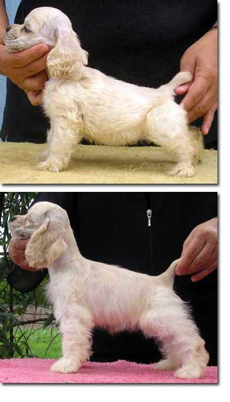
I will start to work with movement. That will take more time because it is the most important aspect of the cocker.
This is the most important thing about dogs, not just about cockers, but as all other breeds. In a breed like cockers. with so much coat, it is not difficult to cover the problems with a good trimming. And if you have enough experience stacking dogs, you will be able to make the dog look beautiful, even when it is not even close to be perfect.
But when the dog starts to move, it will shows all its qualities and faults. The low tailset will be there, the soft back too, especially the problems with the forelegs and rears.
A dog must walk trotting, like a horse. Look these photos:
The first dog has a trotting movement. Take a look at its legs and its triangle shape. But the second movement is not a proper trot. It is called PACE.. The legs are parallel while its is moving, exactly like a camel. Some dogs move like that when they are going faster than a "walk" and not as fast as a trot. Of course that is WRONG. I know only one breed who should move like that — Brazilian filas, but maybe there are others that do the same. BUT COCKERS CAN NOT PACE ok?
There is another "movement mistake" very common. A lot of people (I think they are the majority of the breeders) used to think the faster the dog moves the better the movement is and THAT IS NOT TRUE!
Nowadays the shows more look like races. Who goes faster wins! A proper movement appears like the dog is going in slow motion. As it has lot of REACH and DRIVE (front and rear) it will take more time to stretch the legs to the maximun point than a dog with poor reach. Not sure if you undertand what I mean. Let's try in a different way:
You have two people walking side by side. One is moving with big steps and the other with little ones. But as they are friend they want to be together. What happens? The person with "little steps" will move their legs many more times than the other, but they have the same speed and are walking side by side
The same happens with dogs with good and bad movement. They are able to move the same speed, but the one with little steps (not proper reach and drive — NOT GOOD AT COVERERING GROUND) will have to move the legs many more times than the other with good cover (big steps), isn't that truth?
But do you know what happens? People see that dog moving its legs so fast trying to go the same speed as the dog with good drive and reach and they think that one with the fast little steps is a MOVING MACHINE!!! But in fact the other one, who doesn't take so much effort to move because it has the "big steps" is the one who REALLY MOVES CORRECTLY!
Let's see what the standard says about GAIT:
"Prerequisite to good movement is balance between the front and rear assemblies. He drives with strong, powerful rear quarters and is properly constructed in the shoulders and forelegs so that he can reach forward without constriction in a full stride to counterbalance the driving force from the rear. Above all, his gait is coördinated, smooth and effortless. The dog must cover ground with his action; excessive animation should not be mistaken for proper gait".
Do you see? EXCESSIVE ANIMATION SHOULD NOT BE MISTAKEN FOR PROPER GAIT — it is not because a dog moves its legs very fast it means the even proper movement is right! NEVER FORGET THAT!
When the exhibitors (especially the handlers) noticed a lot of people were making that same mistake (including JUDGES!), they start to make their dogs move faster and faster, like a race. But when you make a dog go so fast in its trot, maybe this dog will show some problems in his back that in fact he doesn't have. But that doesn't seem to mean that much for some handlers . In their opinion; A SHOW DOG MUST MOVE FASTER and that is all.
Another VERY IMPORTANT THING: Time after time we have in our breed dogs that become great winners, especially because they are great movers. It is a great pleasure to watch them flying around the ring, but when you pay attention to their structure — ugly head, narrow front and rears, very long back, you realize that dog is nothing more than a mover.
I believe you've already noticed that there are some top models who aren't that beautiful. In fact you can't understand why they are so famous, but when they see them in the "fashion shows" you notice they have something different, they have all the "eyes" on them. It is "the flash", it is what we say in the dog world "show attitude". And you can be sure the same happens to the dogs.
"The flash" is a great thing to a handler. One dog who is a great mover and has flash is half way to become a BIS winner, but to a breeder THAT CAN NOT BE SO IMPORTANT. Of course I like a dog who is able to move correctly, but it MUST HAVE other qualities. I never will use a dog with a bad head, long back, no bone, no substance, just because it is a great mover or because has "show attitude".
I already had so many dogs who had great structure, they weren't perfect but were very close to the standard but besides that, they were able to move correctly, BUT they didn't have "flash". They were able to finish their championship, but they never got any BIS. And every time they were in the same show with the "big movers" they lost. Is that fair? Well … who said the dog shows are "fair games" ?
So here goes one piece of advice. Movement is very important to show the dog's faults, but it doesn't mean a "flashy dog" is a perfect dog. Don't use a dog with your bitch just because it is a big winner or a great mover, because maybe it will mean nothing in your whelping box.
But let's talk about movement …
As you already saw on this page, a dog with a proper front and proper rear angulation will have a beautiful REACH and DRIVE, an expression we see very often on the stud sire advertisements.
It will be BALANCED.
Let's see these photos in movement:
You see this dog stacked and you believe it is a balanced dog. For the topline you are able to see it has good shoulders, but you are not sure about the rear. You can't see that very well with all that cover, right? And you can't touch the dog to see how it really looks like What should you do? WATCH IT MOVING! When you see this dog's movement you have the confirmation it has a good structure. You trace a line from its two paws together to the back of the dog. And thus trace a line from that point to the front foot and another one to the back foot These two lines must have almost the same size. I used my computer to trace these lines and believe me, THEY ARE EXACTLY THE SAME SIZE. This triangle must have two sides with the same size.
Do you want to see another dog moving, this time a young puppy?
Once again we have the a triangle with 2 sides of the same size.
But what is a DOG THAT'S NOT BALANCED? We must think of him as two parts. Each part will walk with different size of steps. If he doesn't have enough REACH, his "front steps" will be short ones. If he is over angulated in his rear, his "hind steps" will be large ones. So a dog that is not balanced is the one whose "front steps" will not be the same size as his "hind steps".
A dog with bad reach will look like this:
You already learned the front legs should go ahead of the nose of the dog when it is moving. And looking to the triangle, you can see that one side is longer than the other. The longer side shows longer steps. The smaller size, smaller steps. In this case, this dog has much more DRIVE than REACH. His "hind steps" are larger/bigger than the "front step".
And you can find another kind of movement problem when a dog has more drive than reach: SIDE WINDING or SIDLE. What is that? It is when the dog can not move in a straight line. Why does that happen?
Very simple … look the photo of the buff puppy moving (above). Do you notice the paws which are on the floor are very close to each other? All the dogs used to move in that way. But now think of a dog that is not balanced. He doesn't have too much reach (small/short front steps) but as it is over angulated in the rear, he pushes the ground very hard (large/big hind steps). If this dog was moving in a straight line, he would put his hind leg AHEAD of the foreleg. Of course, he can't do that, so what does he do? He puts his hind leg at the side of the foreleg. Look the drawing below.
Let's imagine these are two dogs. The left dog is a balanced one. The red elipses are his forelegs. The blue are his hindlegs, ok? He is moving in a straight line, because of his good reach, his forelegs go ahead of his nose. As he is balanced, you can trace a perfect triangle (green color) showing his steps are the same size.
But the dog on the right isn't balanced. It doesn't have enough REACH (short front steps) and because of that, his foreleg isn't ahead of his nose. On the other hand, he has too much DRIVE (large hind steps) and his hind leg goes ahead of the point his foreleg is. He puts his two right legs side by side and to make that possible, he can't go in a straight line. He must twist his body. It is Mother Nature adjusting the dog's movement to its structure.
It is what Byron Santos (Sherwood Cockers in USA) said: "I guess you have to describe the rear as a "balanced to the front" because no matter how good or bad the front is, God will adjust the rears so the dog can move more adequately"
Believe me, siddle (side winding) movement is much more common than you can imagine, especially in short backed dogs. As I like the short back dogs, I already had a couple of dogs with this problem in my place. And I had opportunity to watch a Doberman National Show here in Brazil (I was the judge's assistant) and I can tell you 90% of the dogs on that show (including the ones imported from USA) had the same problem. It is easier to see the problem in a doberman because there is no coat to cover its legs …
But sometimes you have a dog (very common in puppies) and it moves straight, but when you put the leash on it he will start to to siddle. Sometimes he is doing that because the dog is pulling away from you and not because it has problems in his structure, ok?


